The President's Cabinet

Visit Ben's Guide to learn more about the President's Cabinet.
The President's Cabinet
Another vital part of a presidential administration is the formal collection of the President's closest advisors, or Cabinet. The Cabinet includes the Vice President and the heads, or "secretaries", of each of the fifteen executive departments. Each department has specific areas of responsibility to control.
The cabinet is not mentioned in the Constitution; however, Article II does state the President "may require the opinion of the principle officer in each of the executive departments." The Constitution does not specify how many executive departments can or should be created. President George Washington had four executive department heads in his Cabinet.
Vice President of the United States
The Vice President is the only elected position, besides the President, within a presidential administration. The Vice President serves as a member of the Cabinet in addition to three other duties specified in the Constitution:
- Becomes President if the President is unable to serve
- Presides as President of the Senate
- Opens and counts electoral votes in a Presidential election
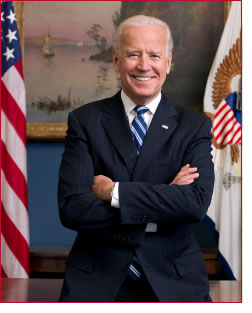
Joe Biden, the Vice President of the United States of America in 2014.
Vice President of the United States
The office of the Vice President is located close to the President's office, also known as the Oval Office, in the West Wing of the White House.
Watch The Vice President (1:46) to learn more.
Visit Vice President to learn more.
Members of the Cabinet
In addition to the Vice President, the cabinet consists of 15 Cabinet secretaries, or heads of each department, that are chosen by the President and must be approved by a majority vote in the Senate. Hearings are held to determine whether appointees will be confirmed.
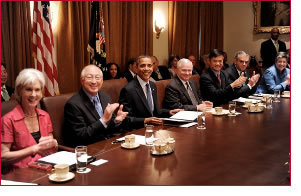
President Barak Obama and members of his cabinet.
Congress and Executive Departments
The Cabinet has grown over the years because the number of executive departments has increased. Executive departments are created by Congress and are subject to its oversight. Individual committees in Congress may subpoena Cabinet officials to aid in their investigations.
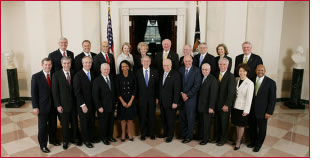
The Bush Cabinet, 2008.
.jpg)
The Clinton Cabinet, 1993.
Members of the Cabinet
Executive departments are also subject to some control by Congress. For example, Congress must approve appropriations or money to carry out programs developed by the departments.
Watch The Presidential Cabinet: The Departments of the Executive Branch (1:55) to learn more.
Organization of Executive Departments
Executive departments are organized into a pyramidal structure with the Cabinet member as the top officer. Individual departments are often comprised of a vast array of organizations and agencies.
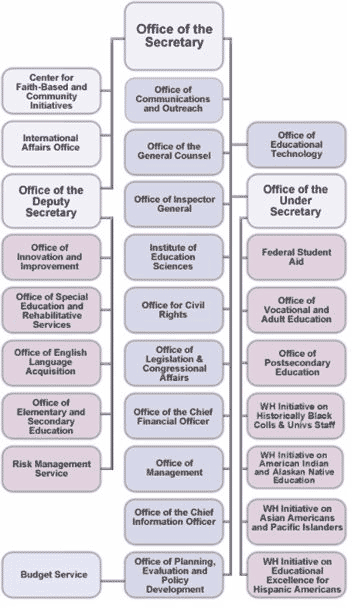
The organization chart for the Department of Education.
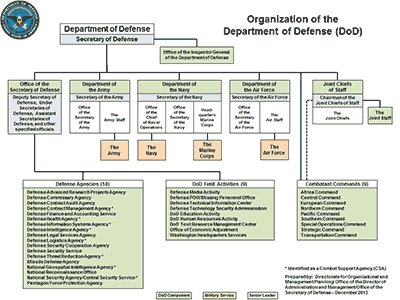
The organization chart for the Department of Defense.
Top Executive Departments
The first three executive departments created by Congress, the departments of State, Treasury, and Defense, are still among the most important today.
The Department of State advises the President on foreign policy matters. The head of the department, the Secretary of State, is the top-ranked member of the Cabinet and a member of the National Security Council.
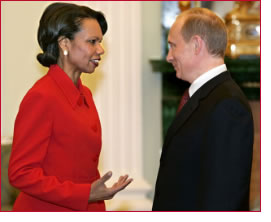
Former Secretary of State Condoleezza Rice speaks with Russian President Vladimir Putin in 2005.
Watch Who is Condoleeza Rice (4:46) and Secretary of State (3:51) to learn more about the former Secretary of State.
Department of Treasury
The Department of Treasury recommends economic, tax, and fiscal policies; and it collects, spends, and manufactures the money required by the country. The Internal Revenue Service (IRS) is just one of the many divisions within the department. The Secretary of the Treasury is a major policy advisor to the President and manages the public debt.
Visit Treasury to learn more about the Department of Treasury.
Department of Treasury
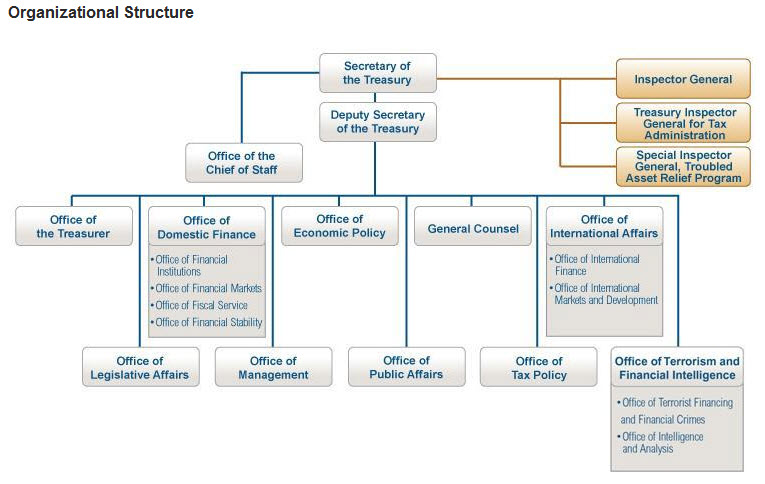
Department of Defense
The Department of Defense (DOD), originally the Department of War, is oversees the armed forces and provides the military forces necessary to prevent war and protect our country. The DOD is the largest executive department and carries out most of the President's duties as Commander in Chief.
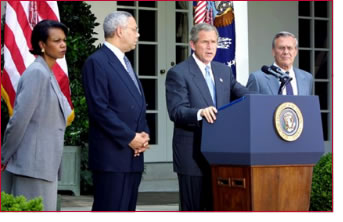
National Security Advisor Condoleeza Rice, Secretary of State Colin Powell, and Secretary of Defense Donald Rumsfeld listen to President George W. Bush speak about the Middle East in 2002.
Department of Defense
The Secretary of Defense and other secretaries (army, navy, and air force) must be civilians. However, the Joint Chiefs of Staff, which advise the Secretary of Defense and President, consist of the top-ranking military officers from each of the armed services.
Visit DOD to learn more about the Department of Defense.
Department of Justice
The Department of Justice is the fourth oldest executive department and the nation's largest law firm. It represents the citizens in enforcing the law.
The Federal Bureau of Investigation(FBI) is one of the most well-known divisions of the department.

The Robert F. Kennedy Department of Justice Building in Washington, D.C.
Department of Justice
The Secretaries of State, Treasury, and Defense along with the Attorney General made up the original Cabinet and are considered the most important members due to the importance of their departments. The Attorney General, head of the Department of Justice, is the only head of an executive department that is not referred to as Secretary.
Visit Justice 101 to learn more about the Department of Justice.
Other Executive Departments
In addition to the top four departments, there are eleven other executive departments whose heads are members of the President's Cabinet. Visit the websites below to learn about them.
- Department of the Interior (1849)
- Department of Agriculture (1862)
- Department of Commerce (1903)
- Department of Labor (1913)
- Department of Health and Human Services (1953)
- Department of Housing and Urban Development (1965)
(more)
Other Executive Departments
Here some more Executive Department websites:
• Department of Transportation (1966)
• Department of Energy (1977)
• Department of Education (1979)
• Department of Veterans Affairs (1988)
• Department of Homeland Security (2003)
Visit Ben's Guide for an overview of the Executive Departments.